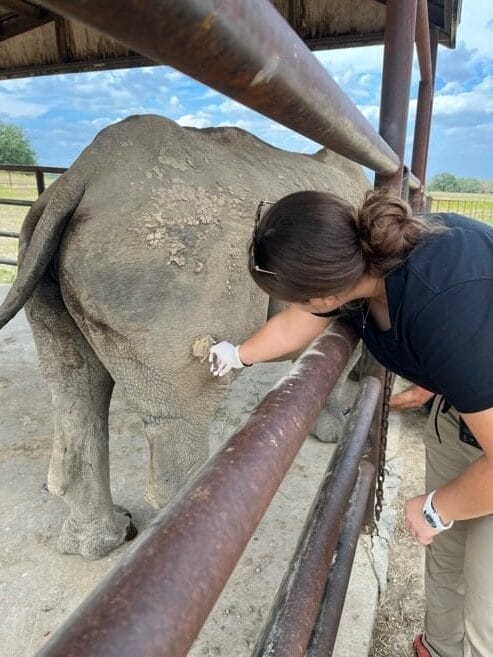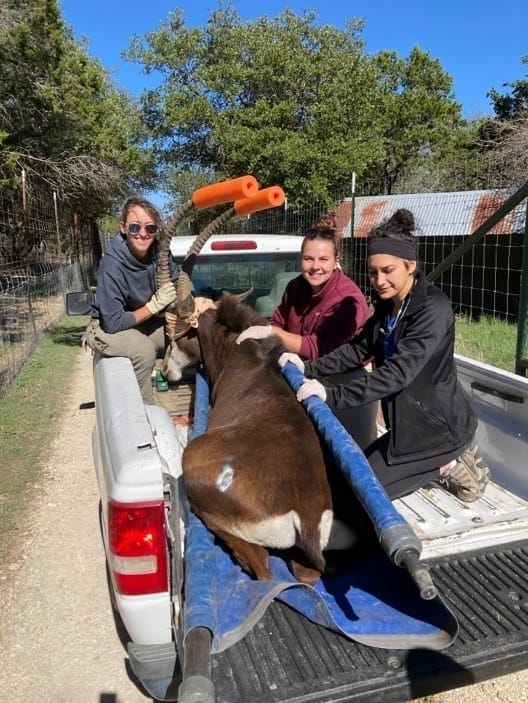Hi! My name is Julia Utting and I am a fourth year vet student at Virginia-Maryland College of Veterinary Medicine. I had the amazing opportunity to complete a 6-week preceptorship at Fossil Rim Wildlife Center to strengthen my career goals of zoo and wildlife medicine. I have done a variety of wildlife disease and conservation work, including wildlife rehab, but I was seeking a place that would give me clinical wildlife work in an AZA accredited facility. I am also a dual degree Master of Public Health (MPH) student, so I love One Health (the interconnectivity between human, animal, and environmental health) and hope to incorporate those principles in my career. Fossil Rim gave me the opportunity to combine my passion for zoo medicine and conservation, while also utilizing One Health principles daily.
Working With Rhinos
During my time here, I was able to perform a wide variety of tasks including wound treatments on M’bili (one of the white rhinos), neonate exams, anesthetic monitoring on a variety of species, deworming and treatments for the Attwater Prairie Chickens, participate in multiple hoofstock immobilizations, and so much more. However, as much as I would love to talk about my experience with everything I did, I am going to specifically discuss cooperative care and the importance it has in treatment of certain species at Fossil Rim.
Cooperative care is when an animal is not only trained to tolerate a procedure, but also is able to opt in or out of participating. Essentially, you are giving the animal a choice. This is something utilized frequently at Fossil Rim, and something that I was able to experience for the rhinos and giraffe here. The animals are conditioned to stand still for procedures with a food incentive and without physical or chemical restraint, such as sedation.


M'bili was my first encounter with this at Fossil Rim. She is one of our older white rhinos and has a history of pressure sores on her hips that require wound treatments, sometimes multiple times a week. She has been trained by animal care staff to come up to the fence and stand still (with food, of course) as we remove her old bandages, clean the wounds, and apply new bandages. She is also trained to “turn” so that we can access both hips. During this time, we can also collect blood samples or perform any other treatments she may need. She has 100% free access to the rest of her yard when we do this, so it is truly her choice to participate.
On The Job With Giraffe
One of my other favorite examples of this is with Mananasi, our bull giraffe. He has a history of swelling in both right legs and is being treated and assessed by an equine surgeon for specialty care. Mananasi is VERY food motivated and has been trained by the hoofstock team to tolerate things being done to those joints, such as hair clipping and the application of ultrasound gel. This training translated to the real deal when the equine surgeon was able to come out and ultrasound his joints with no sedation! This procedure allowed us to have a better understanding of why his joints are swollen and the next steps for care. Additionally, this was done in his pasture without physical restraint, so he had free access to walk away if he chose. He received lots of food though, so he was pretty happy.

The hands-on and wide variety of experience at Fossil Rim were some of the best aspects of my time here. I also learned so much from the whole vet team: Holly, Julie, Jasmine, and Allyssa, and the rest of the animal care staff. Holly and Julie love teaching and are excellent resources for learning everything from anesthetic drug usage to common diseases, and taxonomy of species.
Prior to coming here, I had a good idea that I wanted to pursue zoo med after graduation, specifically with a focus on conservation and One Health, but wanted to be sure before embarking on the long journey of board certification. After this experience, I can confidently say that not only do I plan to pursue this career field and board certification, but I also hope to return to Fossil Rim in the future. There’s nothing quite like working in a place so similar to the natural habitat of many of these species. If any vet student is interested in zoo and/or wildlife medicine, I couldn’t recommend this preceptorship program enough. The short time I had here wasn’t enough, but it was definitely some of the best 6 weeks I’ve ever had!

